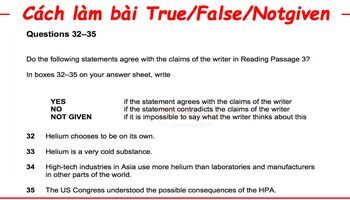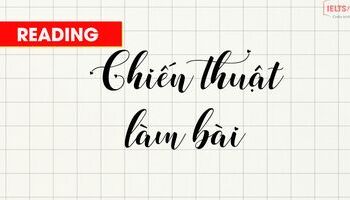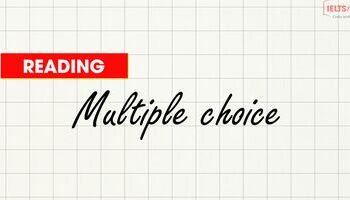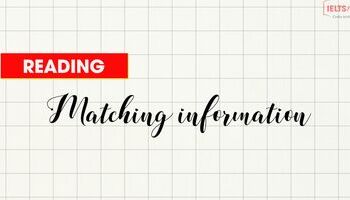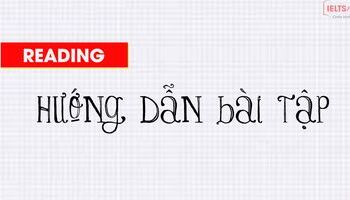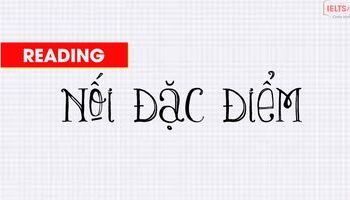Dạng bài True/False/Not given được đánh giá là dạng khó nhất trong bài thi IELTS Reading. Tuy nhiên, bạn đừng vội lo lắng nhé, hãy tham khảo các bí quyết làm bài do IELTS Fighter gợi ý sau đây và áp dụng vào quá trình ôn thi của mình nhé!
Thông tin dạng bài
1. Thông tin chung
Đây là dạng bài yêu cầu bạn phải quyết định thông tin được đưa ra ở câu hỏi là Đúng hay Sai hoặc là thông tin không có trong bài đọc (Not Given). Dạng câu hỏi này sẽ đưa cho bạn 1 list các câu hỏi, và bạn cần chọn thông tin đó là Đúng – Sai – Không được đưa ra.
True – Nếu thông tin câu hỏi được đưa ra có trong bài thì là đúng, bạn chọn True
False – Nếu thông tin câu hỏi được đưa ra trái ngược với thông tin trong bài thì là sai, bạn chọn False
Not Given: Nếu thông tin được đưa ra là không có trong bài hoặc không xác định được thì chọn đáp án này.
2. Phân biệt hai dạng bài
Format đề:
Thông thường có 2 loại câu hỏi cho dạng đề này:
- True/False/Not given: là dạng cần dựa vào facts có trong bài. Dấu hiệu nhận biết: Do the following statements agree with the informationgiven in Reading…?
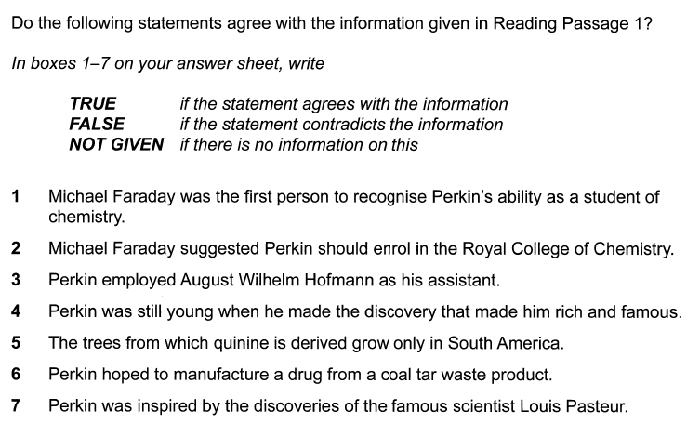
- Yes/No/Not given: là dạng cần suy luận theo ý kiến, quan điểm của tác giả Dấu hiệu nhận biết: Do the following statements agree waith the claims of the writer in Reading…?

Chiến thuật làm bài
Các bước làm bài:
Bước 1 Đọc kỹ yêu cầu bài & xác định dạng câu trả lời (True/ False hay Yes/ No)
Bước 2 Đọc hiểu statement đầu tiên & gạch chân – đánh dấu thứ tự từ khóa
Bước 3 Skim & tìm đoạn văn chứa thông tin statement 1
Bước 4 Đọc kỹ vùng thông tin
Đối chiếu với statement 1 & đưa ra câu trả lời cho statement 1
Bước 5 Lần lượt lặp lại bước 2-4 với các statement còn lại
Phân tích cụ thể
Read the text and do the task below
In recent years, it has been shown that plants, more accurately roots, play a crucial part in purifying dirty water before it enters seas and rivers. In 15th-century Britain, dirty water was purified by passing through the wetlands. People began to realize that the “natural” way of water purification was effective. Nowadays subsurface flow wetlands (SSFW) are a common alternative in Europe for the treatment of wastewater in rural areas, Mainly in the last 10 to 12 years there has been a significant growth in the number and size of the systems in use. The conventional mechanism of water purification used in big cities where there are large volumes of water to be purified is inappropriate in rural areas.
Questions 1-3
Do the following statements agree with the information given in Reading Passage ? In boxes 1-3 on your answer sheet, write
TRUE if the statement agrees with the information
FALSE if the statement contradicts the information
NOT GIVEN if there is no information on this
1. The reed bed system is a conventional method for water treatment in urban areas.
Bước 1. Đọc kỹ yêu cầu bài & xác định dạng câu trả lời- True/ False/ Not Given
Bước 2. Đọc hiểu statement đầu tiên & gạch chân và đánh thứ tự từ khóa
- Từ khoá là những từ chứa nghĩa quan trọng của câu.
- Từ khoá thường là danh từ (chỉ người, chỉ địa điểm, mốc thời gian…), tính từ, trạng từ, động từ hành động, liên từ (thể hiện mối liên hệ giữa các thông tin trong câu) và chú ý các từ nhấn mạnh nghĩa khẳng định hoặc phủ định (từ ‘not’ trong ví dụ).
NOTE: Đối với dạng True/ False/ Not given cần đặc biệt chú ý các từ khóa mang nghĩa tuyệt đối ( như always, total, most, almost, …).
Ví dụ: 1.The reed bed system is a conventional method for water treatment in urban areas.
Bước 3. Skim & tìm đoạn văn chứa thông tin statement 1
Bước 4.
Đọc ký thông tin vừa tìm được
- Tìm các từ khóa 1’, 2’, 3’, 4’,… tương ứng đã được paraphrasetừ các từ khóa 1, 2, 3, 4,… gạch chân trong statement.
Đối chiếu với statement 1 & đưa ra câu trả lời cho statement 1
- Có 3 trường hợp:
| Trường hợp | Đối chiếu | Câu trả lời |
| 1 | Tất cả các từ khóa trong đoạn văn (1’, 2’, 3’, 4’,…) đều có nghĩa tương đương với các từ khóa trong câu hỏi (1, 2, 3, 4) – sử dụng từ đồng nghĩa/ paraphrase | True/ Yes |
| 2 | Có MỘT từ khóa bị phủ nhận/ diễn đạt ý đối lập Ví dụ: Ta tìm được 1 = 1’, 2 = 2’, 3 = 3’ nhưng 4’ và 4 diễn đạt ý trái ngược – sử dụng từ trái nghĩa hoặc từ mang nghĩa phủ định | False/ No |
| 3 | Có MỘT từ khóa không thể tìm thấy trong vùng thông tin đó Ví dụ: Ta tìm được 1 = 1’, 2 = 2’, 3 = 3’ nhưng không thể tìm từ khóa 4’ tương đương hay phủ nhận 4 | Not given |
Ví dụ: Thông tin của statement “ The reed bed system is a conventional method for water treatment in urban areas” –
Nằm trong “Nowadays subsurface flow wetlands (SSFW) are a common alternative in Europe for the treatment of wastewater in rural areas”.
Các từ được paraphrase :
- water treatment - treatment of wastewater
Các từ khác với thông tin câu văn:
- The reed bed system ≠ subsurface flow wetlands
- conventional method ≠ common alternative
Đáp án là False.
Bước 5. Lần lượt lặp lại bước 2-4 với các statement còn lại
Vị trí các statement sẽ tương ứng với vị trí thông tin trong đoạn văn.
Ví dụ: đoạn thông tin của câu 2 sẽ nằm sau đoạn thông tin của câu 1; nằm trước đoạn thông tin câu 3.
Check- up
Read the rest of the passage and answer the question 2-3
The common reed has the ability to transfer oxygen from its leaves, down through its stem and rhizomes, and out via its root system. As a result of this action, a very high population of microorganisms occurs in the root system, in zones of aerobic, anoxic, and anaerobic conditions. As the waste water moves very slowly through the mass of reed roots, this liquid can be successfully treated. The reason why they are so effective is often because within the bed’s root sector, natural biological, physical and chemical processes interact with one another to degrade or remove a good range of pollutants.
Dirty water from households, farms and factories consume a lot of oxygen in the water, which will lead to the death of aquatic creatures. Several aquatic plants are important in purifying water. They not only absorb carbon dioxide and release oxygen into the water, improving the environment for fish, but absorb nutrients from the welter as well. Britain and the G.S. differ in their preference of plants to purify water. Bulrushes (Scirpus spp.) and rushes (Juncus spp.) are excellent water purifiers. They remove excess nutrients from the water as well as oil and bacteria such as Escherichia coli and Salmonella. However, algae grow freely in summer and die off in winter. Their remains foul the bottom of the pool.
Questions 2-3
Do the following statements agree with the information given in Reading Passage ? In boxes 1-3 on your answer sheet, write
TRUE if the statement agrees with the information
FALSE if the statement contradicts the information
NOT GIVEN if there is no information on this
2. In the reed roots, there is a series of processes that help break down the pollutants.
3. Escherichia coli is the most difficult bacteria to eliminate.
Mẹo làm bài
1. Các vấn đề cần lưu ý
Khi làm bài thi IELTS Reading dạng True/False thì thí sinh mắc phải lỗi sau:
- Nhầm lẫn không biết chọn False và Not Given
- Dùng quan điểm của mình và suy luận (Not Given, False hoặc True)
- Không tìm được đoạn có chứa thông tin cần tìm, mất nhiều thời gian để đọc cả bài rất lâu.
- Thiếu vốn từ, không hiểu được thông tin. Đây là là điều mà những bạn đang ở band thấp mắc phải. Các bạn chú ý học từ vựng Academics, từ đồng nghĩa để hiểu được nhiều bài đọc hơn. Trong đoạn văn luôn có các từ đã được viết lại – paraphrasing nên dễ khiến bạn khó hiểu nếu không có vốn từ tốt.
- Dành nhiều thời gian cho 1 câu hỏi quá khó. Tips là nên làm câu dễ trước, câu khó sau nhé.
2. Tips làm bài
Trước hết, phân tích qua dạng bài này, thí sinh khi làm bài Reading thường gặp khó khăn ở việc xác định đáp án là Not given hay không bởi không biết thông tin cần tìm kiếm ở đâu. Các bạn cố gắng tìm keywords thay vì cố gắng hiểu nghĩa chung của toàn câu vì thế mà thường bối rối.
Trong bài thi, bạn chú trọng nhiều vào keywords, nhưng có thể không có keywords mà đó có thể là bẫy “synonyms” – từ đồng nghĩa.
Đặc biệt chú ý, True là đáp án phải chính xác, nếu nghĩa chỉ tương tự thì vẫn là False. Vì thế, bạn cần cẩn trọng trong phần thi này để không bị mắc bẫy của bài thi.
Thêm nữa, Not Given không có nghĩa là không có từ nào trong câu hỏi thuộc bài đọc. Vì thế, các bạn cần chú ý để không bị lẫn khi làm bài thi này.
Vậy thì tips để làm bài như sau:
- Khi làm bài, các bạn luôn đọc chỉ dẫn cẩn thận
- Bạn đừng đoán mà hãy đọc kỹ để dựa vào đó làm bài
- Đọc tất cả các câu hỏi và cố gắng hiểu ý toàn câu thay vì chăm chăm tìm keywords. Đặc biệt chú ý đừng quên những từ quan trọng ví dụ như các từ chỉ tần suất. Chỉ cần có một số từ như thế này sẽ thay đổi toàn bộ nghĩa của câu “some, all, mainly, often, always and occasionally.” Ví dụ ‘Coca-Cola has always made its drinks in the U.S.A.’ sẽ có nghĩa khác với ‘Coca-Cola has mainly made its drinks in the U.S.A.’
- Chú ý những động từ quan trọng trong câu ví dụ như “suggest, claim, believe and know”. So sánh hai câu này nghĩa khác hẳn nhau: ‘The man claimedhe was a British citizen,’ and ‘The man is a British citizen’.
- Skim và Scan – đọc lướt là kỹ năng cơ bản nhưng với dạng bài này thì bạn cần đọc kỹ phần chứa đáp án để tránh bỏ sát và hiểu sai.
- Bạn cần chú ý từ đồng nghĩa – synonyms thay vì chăm chăm vào keyswords. Điều này sẽ giúp bạn xác định được phần chính xác chứa đáp án
- Tập trung vào câu hỏi rồi so sánh với phần chứa thông tin để xác định đáp án. Nhớ rằng ý nghĩa cần đúng chính xác với thông tin trong bài, nếu chỉ tương tự vẫn là False – Sai.
- Nếu không thấy thông tin trong bài thì hãy chọn Not Given, đừng tốn thêm thời gian. Nếu sau khi làm xong thừa thời gian thì bạn xem lại để chắc chắn hơn.
- Nếu bạn không thực sự chắc câu trả lời hoặc không tìm thấy câu trả lời cho câu hỏi đó thì hãy đánh dấu là ‘not given’.
- Với dạng bài này, câu trả lời sẽ theo trật tự xuất hiện trong bài đọc do đó bạn có thể tham khảo so sánh.
Luyện tập
Passage 1
History of telegraph in communication
Jean-Antoine Nollet was a French clergyman and physicist. In 1746 he gathered about two hundred monks into a circle about a mile (1.6 km) in circumference, with pieces iron wire connecting them. He then discharged a battery of Leyden jars through the human chain and observed that each man reacted at substantially the same time to the electric shock, showing that the speed of electricity's propagation was very high. Given a more humane detection system, this could be a way of signaling over long distances. In 1 748, Nollet invented one of the first electrometers, the electroscope, which detected the presence of an electric charge by using electrostatic attraction and repulsion.
After the introduction of the European semaphore lines in 1792, the world's desire to further its ability to communicate from a distance only grew. People wanted a way to send and receive news from remote locations so that they could better understand what was happening in the world around them—not just what was going on in their immediate town or city. This type of communication not only appealed to the media industry, but also to private individuals and companies who wished to stay in touch with contacts. In 1840 Charles Wheatstone from Britain, with William Cooke, obtained a new patent for a telegraphic arrangement. The new apparatus required only a single pair of wires, but the telegraph was still too costly for general purposes. In 1 845, however, Cooke and Wheatstone succeeded in producing the single needle apparatus, which they patented,and from that time the electric telegraph became a practical instrument, soon adopted on all the railway lines of the country.
It was the European optical telegraph, or semaphore, that was the predecessor of the electrical recording telegraph that changed the history of communication forever. Building on the success of the optical telegraph, Samuel F. B. Morse completed a working version of the electrical recording telegraph, which only required a single wire to send code of dots and dashes. At first, it was imagined that only a few highly skilled encoders would be able to use it but it soon became clear that many people could become proficient in Morse code. A system of lines strung on telegraph poles began to spread in Europe and America.
In the 1840s and 1850s several individuals proposed or advocated construction of a telegraph cable across the Atlantic Ocean, including Edward Thornton and Alonzo Jackman. At that time there was no material available for cable insulation and the first breakthrough came with the discovery of a rubber-like latex called gutta percha. Introduced to Britain in 1843, gutta percha is the gum of a tree native to the Malay Peninsula and Malaysia. After the failure of their first cable in 1850, the British brothers John and Jacob Brett laid a successful submarine cable from Dover to Calais in 1851. This used two layers of gutta percha insulation and an armoured outer layer. With thin wire and thick insulation, it floated and had to be weighed down with lead pipe.
In the case of first submarine-cable telegraphy, there was the limitation of knowledge of how its electrical properties were affected by water. The voltage which may be impressed on the cable was limited to a definite value. Moreover, for certain reasons, the cable had an impedance associated with it at the sending end which could make the voltage on the cable differ from the voltage applied to the sending-end apparatus. In fact, the cable was too big for a single boat, so two had to start in the middle of the Atlantic, join their cables and sail in opposite directions. Amazingly, the first official telegram to pass between two continents was a letter of congratulation from Queen Victoria of the United Kingdom to the President of the United States, James Buchanan, on August 16, 1 858. However, signal quality declined rapidly, slowing transmission to an almost unusable speed and the cable was destroyed the following month.
Do the following statements agree with the information given in Reading Passage In boxes 1-6 on your answer sheet, write
TRUE if the statement agrees with the information
FALSE if the statement contradicts the information
NOT GIVEN if there is no information on this
1. In the research of the French scientist, metal lines were used to send messages.
2. People increasingly hoped to explore ways of long-distance communication in the late eighteenth century.
3. Using Morse Code to send message needed special personnel to first simplify the message,
4. Morse was a famous inventor before he invented the code.
5. Water was significant to early telegraph repeater stations on the continent.
6. The Australian Government offered funds for the first overland line across the continent.
Trên đây là hướng dẫn cách làm bài IELTS Reading - True/False/Notgive và Yes/No/Notgiven cơ bản, các bạn cùng luyện tập với video nữa nhé.
Bài phân tích đề thi thật, thực hiện bởi IELTS Fighter, vui lòng ghi nguồn nếu sử dụng chia sẻ. Xin cảm ơn.
Xem thêm dạng bài:
IELTS Reading: Chiến thuật làm bài MATCHING HEADINGS
